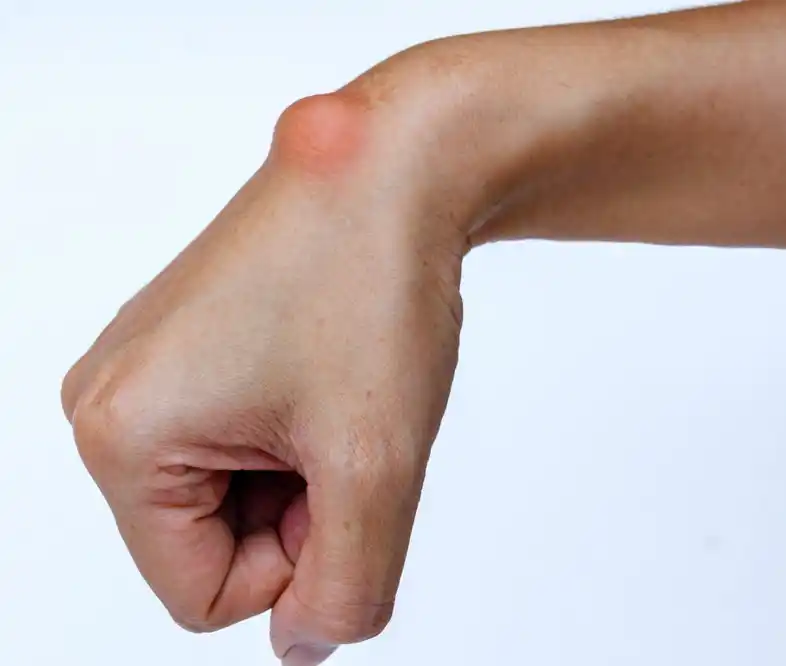expert Ganglion Cyst treatment in pittsburgh
Ganglion Cyst (Finger, Hand, or Wrist Lump/Bump)
A lump or bump on your hand or wrist could be a ganglion cyst, a common type of benign growth that forms along tendons or joints, most often at the top or bottom of the wrist joint. Dr. Spiess at Pittsburgh Hand & Nerve is highly experienced in diagnosing and treating ganglion cysts, including surgery for ganglion cyst removal if needed.
What is a Ganglion Cyst?
Ganglion cysts are non-cancerous bumps that are filled with jelly-like fluid and they can range in size from small as a pea to as large as a golf ball. They usually develop at a joint and cause the tissue that surrounds the joint to bulge out of place. Ganglion cysts have been nicknamed “bible bumps” or “bible cysts” because in the days before medical treatment was widely available, people would sometimes attempt to treat them by hitting them with a heavy book. Fortunately, we now have more advanced treatment options for ganglion cysts.
Signs and Symptoms of a Ganglion Cyst
Ganglion cysts are often slow growing and can fluctuate in size, growing larger with activity and smaller with rest. They often occur on the wrist, but may also grow on fingers, elbows, or feet. A small ganglion cyst does not usually cause any pain, but a larger bump may cause tenderness or discomfort. If a ganglion cyst grows in a way that interferes with a nerve it can cause pain, numbness, or tingling.
Ganglion Cyst Causes
The exact cause of a ganglion cyst is unknown, but they may be the result of repetitive stress on the joint or minor ligament injuries over time. Ganglion cysts are most common among women from 15 to 40 years of age and they often affect gymnasts.
Ganglion Cyst Treatments
If you have any type of growth or bump, it is important to schedule a consultation with Dr. Spiess at Pittsburgh Hand & Nerve to evaluate it. During your appointment, we will assess your bump to determine if it is a ganglion cyst. We may perform additional tests such as ultrasound, and x-rays, or order an MRI to assist in making the ganglion cyst diagnosis.
Half of all ganglion cysts may resolve on their own, so if your bump is not causing pain the initial treatment plan may be to monitor it and wait. If you are experiencing discomfort, non-surgical treatment options include bracing the hand to restrict movement. If your ganglion cyst is resistant to other treatments or is impinging on a nerve, surgery to remove it may be necessary. Contact Pittsburgh Hand & Nerve to learn more about personalized treatment options or to schedule an appointment.

Basilar Thumb Joint (CMC) Arthritis expert in pittsburgh
What Is Basilar Thumb (CMC) Arthritis?
The thumb is one of the most common joints in the hand to develop arthritis—more specifically, wear-and-tear arthritis known as osteoarthritis (OA). This affects the base of the thumb—the carpometacarpal (CMC) joint—which is shaped like a saddle and allows the thumb to have a wide range of motion. Thumb arthritis often runs in the family and develops over time as we age. It can be very painful and limit your thumb’s ability to move normally, which is why severe cases of the condition may require reconstructive surgery.
Signs & Symptoms
While some people can live with thumb arthritis without any problem at all, other may find their disease flares up when making basic motions, like turning a doorknob, opening a jar, or even writing, resulting in severe pain and loss of hand function. In general, arthritis in the thumb joint typically causes the following symptoms:
- Pain and weakness when pinching or grasping
- Grinding sensation from the bones rubbing against the joint
- Limited thumb movement
- Thumb begins to look deformed as bone spurs develop, ligaments stretch, and the join collapses
Dr. Spiess at at Pittsburgh Hand & Nerve can diagnose your thumb arthritis by simply discussing your symptoms and examining your hand. They may also recommend an x-ray to better understand your disease and plan for a potential surgery.
Causes
OA of the basilar thumb joint is caused by the cartilage beginning to thin. When there isn’t enough cartilage to help the bones glide smoothly, bone spurs can form, leading to more severe symptoms. The most common factors that lead to thumb arthritis include the following:
- Family history
- Natural aging process
- Previous injuries
Although anyone can develop thumb arthritis, the disease occurs more often in women than men. It also tends to develop earlier in women, usually in those over age 40.
Treatment
Dr. Spiess can diagnose your thumb arthritis by going over your medical history, discussing your symptoms, and looking at how well your thumb functions. Since thumb arthritis gradually develops with age, many people feel okay without getting any treatment. However, if your symptoms begin to affect your daily living, our practice offers treatments ranging from non-invasive options to surgery. These can include the methods below:
- Topical anti-inflammatory
- Use of a splint
- Steroid injections
- PRP injection
- Surgery
Typically, all non-surgical treatments are exhausted before surgery is recommended. Treating thumb arthritis with surgery typically means removing the diseased bone and reconstructing the joint, a procedure in which a tendon can be moved to the area to help reconstruct the ligaments and support the thumb bone.
If you do undergo surgery, you’ll need to wear a splint for several weeks after surgery, followed by hand therapy. More specific details about your treatment will be discussed during your consultation at at Pittsburgh Hand & Nerve. We will create an individualized treatment plan that meets your needs.
